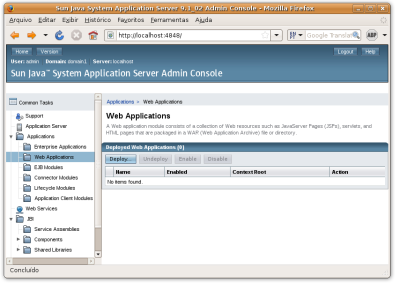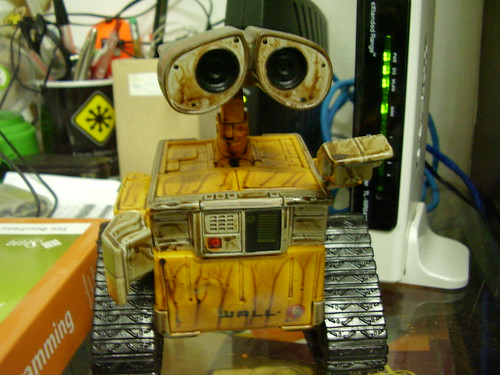
Silveira Neto Posts
Ainda essa semana eu vou fazer três palestras. Olhe aà se você não vai estar por perto. 😉
- 29/10 РQuarta-feira 20:30 РPalestra sobre NetBeans no na VII Semana de TI e Telecomunica̵̤es da FIC.
- 30/10 РSexta-feira 09:30 РPalestra sobre OpenSolaris tamb̩m na VII Semana de TI e Telecomunica̵̤es da FIC.
- 01/11 – Sábado 15:20 – Palestra Apresentando o CEJUG e o poder do Java em Iguatu no Encontro PHP & Java.
Como prometido, aqui estão os slides da palestra sobre certificações na Unifor.
Downloads:
Aqui estão as fotos das palestra minha e do Carneiro. Não esqueçam de entrar no Unifor Sun OSUM. 😉
This is a draft of study guide based on SCSNI (Sun Certified Specialist Netbeans IDE) exam objectives.
| Exam Objetive | Resources |
|---|---|
| Section 1: IDE Configuration | |
| 1.1 Demonstrate the ability to configure the functionality available in the IDE, including using enabling and disabling functionality and using the Plugin Manager. | |
| 1.2 Explain the purpose of the user directory and the netbeans.conf file and how these can be used to configure the IDE. | |
| 1.3 Demonstrate the ability to work with servers in the IDE, such as registering new server instances and stopping and starting servers. | |
| 1.4 Describe how to integrate external libraries in the IDE and use them in coding and debugging your project. | |
| 1.5 Demonstrate knowledge of working with databases in the IDE, including registering new database connections and tables running SQL scripts. | |
| 1.6 Describe how to integrate and use different versions of the JDK in the IDE for coding, debugging, and viewing Javadoc documentation. | – |
| Section 2: Project Setup | |
| 2.1 Describe the characteristics and uses of a free-form project. | – |
| 2.2 Demonstrate the ability to work with version control systems and the IDE. (Which VCS’s are available, which ones you need an external client for, how to pull sources out of a repository, view changes, and check them back in). | |
| 2.3 Describe the ways in which you can change the build process for a standard project, such as configuring project properties and modifying the project’s Ant build script. | – |
| 2.4 Configure your project to compile against and run on a specific version of the JDK. | – |
| Section 3: Java SE Development | |
| 3.1 Demonstrate the ability to create NetBeans projects from the source code of an existing Java SE program. | |
| 3.2 Describe how to manage the classpath of a Java SE project, including maintaining a separate classpath for compiling and debugging. | – |
| 3.3 Demonstrate the knowledge of the NetBeans GUI Builder and the ability to lay out and hook up basic forms using it. | |
| 3.4 Demonstrate the ability to package and distribute a built Java Desktop project for use by another user. | – |
| Section 4: Java EE Web Development | |
| 4.1 Describe how to create a NetBeans project from the source code of an existing Web application. | – |
| 4.2 Distinguish between a visual web application and web application. | |
| 4.3 Demonstrate knowledge of which web frameworks are available in NetBeans IDE and how they are added to and used in a web application. | |
| 4.4 Describe how to monitor HTTP requests when running a web application. | |
| 4.5 Demonstrate a knowledge of basic tasks related to building and deploying web applications to a server, such as changing the target server and undeploying an application. | |
| Section 5: Editing | |
| 5.1 Describe the purpose and uses of refactoring and demonstrate the ability to perform basic refactoring on Java source code. | |
| 5.2 Describe how to use the Options window to change the default appearance and behavior of the Source Editor. | – |
| 5.3 Describe the ways that the IDE highlights errors in source code and the tools the IDE offers for correcting those errors. | – |
| 5.4 Demonstrate the ability to use editor hints, such as implementing all the methods for an implemented interface | – |
| 5.5 Demonstrate the ability to use live code templates such as automatic generation of constructors, try/catch loops, and getters and setters. | – |
| Section 6: Testing, Profiling, and Debugging | |
| 6.1 Demonstrate the ability to work with JUnit tests in the IDE, such as creating JUnit tests and interpreting JUnit test output. | |
| 6.2 Describe how to debug a local (desktop) application, including setting breakpoints and stepping through code. | |
| 6.3 Describe the difference between local and remote debugging and describe how to debug a remote (web) application. | – |
| 6.4 Describe the purpose of profiling applications and how to profile a local desktop application in the IDE. | |
More useful resources:
- SCSNI Study Group from Wagner R. Santos. GREAT work!
- NetBeans Docs & Support. Home of best NetBeans documentation.
- Netbeans IDE Certification Exam Study Guide. A list of resources for SCSNI at NetBeans Wiki.
- NetBeans Screencasts. Just watching some of them (about 10 minutes each) can grantee you a lot of question in your exam.
Please, collaborate in the comments with others resource links (with section number). Let’s complete this guide.

Pipes, Creative Commons photo by flattop341.
1. The Problem
Internet is full of long urls and meaningless.
Long urls are difficult to remember or print, usually full of redundancy and low semantic. With short and meaningful urls you can avoid thes problems and even achieve profitable goals with SEO
SEO (search engine optimization) technics.
There are services like Tiny URL, Fancy URL, Moo URL and others. Although they solve part of the problems, they bring several others. Another problem is if you have a web site like example.com and use a third-party service for short urls you are losing part of your mind-share with your users and clients.
As an example, if a example.com company wants to promote a open work position would be preferable spread a example.com/jobs instead of a tinyurl.com/examplejobs, or even worst, a tinyurl.com/3i4i592 (meaningless hash).
2. Solution Approach
I created a little program called xort that can be placed on your own server and provide you own short maintening your base url.

I use a pipe abstraction. Each pipe redirects from a key url to an output url.
The idea is that you have xort installed and associated into your domain (preferably on /x). A pipe inside example.com would be like example.com/x/jobs.
3. Tools
All those tools are multi platform, open source and free.
3.1 Glassfish Application Server

Glassfish is an open source application server project led by Sun Microsystems for the Java Enterprise Edition (Java EE) platform. It’s very easy to install and run and have a very nice administration web interface where you can do from simple tasks like deploy a application to more complexes like clustering.

Glassfish Admin Console
To develop the application I’m using NetBeans 6.5 Beta that comes with Glassfish V3 prelude b15b. Netbeans also provides a integration of project, database and web server.

Nevertheless, Glassfish has no dependencies with any IDE and perfectly works by alone. If you need I wrote this post explaining how to install and deploy a application on Glassfish from scratch.
3.2 MySQL Relational Database

MySQL is a relational database management system and probably the most used database on internet (has more than 11 million installations). It’s also very easy to install and administer, through command line or many gui interfaces.
To install MySQL and JDBC driver on Ubuntu just run as root:
# apt-get install mysql-server libmysql-java
After installing and configuring it you can test the jdbc driver throught this servlet code. You can optionally register the MySQL on NetBeans to have a easier access to it thought the service tab.

At the command line you can invoke mysql command line interface and use MySql commands or SQL queries. I’ll login and create a database called xort:
$ mysql -u username -p
Enter password:
Welcome to the MySQL monitor. Commands end with ; or \g.
Your MySQL connection id is 13
Server version: 5.0.51a-3ubuntu5.3 (Ubuntu)Type ‘help;’ or ‘\h’ for help. Type ‘\c’ to clear the buffer.
mysql> create database xort;
Query OK, 1 row affected (0.06 sec)
You could also create this database by an SQL statement:
CREATE DATABASE xort;
To select the database xort:
mysql> use xort;
Reading table information for completion of table and column names
You can turn off this feature to get a quicker startup with -ADatabase changed
mysql>
Now we create a database called pipes with fields pin (pipe in) and pout (pipe out). They represent the input url and the output url of our pipe abstraction.
CREATE TABLE pipes (
pin varchar(255) NOT NULL,
pout varchar(255)
);
As we expect a lot of searches queries on this table, we can optionally create a index for it on pin field. This can reduce ours searches from O(n) to O(logn) (because pin’s will be ordered so don’t need to look all pipes, we can use logn algorithms like binary search).
CREATE INDEX pinindex ON pipes (pin);
Another trick to improve our speed is recycling connections through connection pools.

Creating a pool of MySQL connections on Glassfish is very easy. There’re two good tutorials on this subject:
And now we populate the database with some initial pipes.
INSERT INTO pipes VALUES ('blog','http://silveiraneto.net');
INSERT INTO pipes VALUES ('cejug','http://cejug.org/display/cejug/Home');
INSERT INTO pipes VALUES ('orkut','http://www.orkut.com.br/Main#Profile.aspx?rl=ls&uid=12443310329436634134');
INSERT INTO pipes VALUES ('glassfish','http://glassfish.dev.java.net');
INSERT INTO pipes VALUES ('mysql','http://dev.mysql.org');
INSERT INTO pipes VALUES ('twitter','http://twitter.com/silveira');
INSERT INTO pipes VALUES ('lab', 'http://maps.google.com/maps?f=q&geocode=&q=campus+do+pici&g=Fortaleza,+Brazil&ie=UTF8&t=h&ll=-3.745978,-38.574023&spn=0.002452,0.004823&z=18');
INSERT INTO pipes VALUES ('videos', 'http://br.youtube.com/user/NetoSilveira');
INSERT INTO pipes VALUES ('photos', 'http://flickr.com/photos/silveiraneto/');
4. Program
Basically we have just a program that implement this simple behavior:
- separate the key from the url.
- if the key is a pin from a pipe then redirect to that pout.
- else provide a way to create a new pipe.
- list all pipes.
- provide a way to remove a pipe.
To get the key we need to separate the proper part of the request uri:
String uri = request.getRequestURI();
String key = uri.substring(request.getContextPath().length()+1);
After that we check if it matches with a pin of some pipe. In this case we redirect user for the correspondent pout:
response.sendRedirect(pout);
Notice that using this approach we can connect a url to a extern or intern url (even to another pipe).
5. Download
Check out the xort project and sources at xort.dev.java.net:
Or grab sources and the current build with:
svn checkout https://xort.dev.java.net/svn/xort/trunk xort
Parameters can be passed by the the web.xml file:
Set if users can add new pipes using the web interface.
allowNewPipes
true
JDBC driver to use
driver
com.mysql.jdbc.Driver
Username to login on the database.
username
root
Password for the given username.
password
yourpassword
JDBC path to database.
database
jdbc:mysql://localhost:3306/xort
Xort up and running:
[youtube]b2Mrk8XfvKk[/youtube]
[youtube]64u1pYsCnT8[/youtube]
Teddy brincando com a bolinha laranja dele e fazendo charme para as câmeras.
My slides about a overview on JavaFX at our last CEJUG event.
Downloads:


Here a little screncast showing the live preview feature on the NetBeans JavaFX Plugin.
[youtube]vCWQtQgdpUA[/youtube]
You can also download the orignal screencast in higher resolution netbeans_javafx_preview.ogg (15 Mb). Photos of the presentation at my Flickr album.

A new toy in my desk. One of many I gave myself in the children’s day this year.
Put on your sunday clothes!
[youtube]iodViuPZBz4[/youtube]
Another impressive talk from TED Ideas Worth Spreading about bonobos monkeys, abilities, language and culture.
Description: Savage-Rumbaugh’s work with bonobo apes, which can understand spoken language and learn tasks by watching, forces the audience to rethink how much of what a species can do is determined by biology — and how much by cultural exposure.



